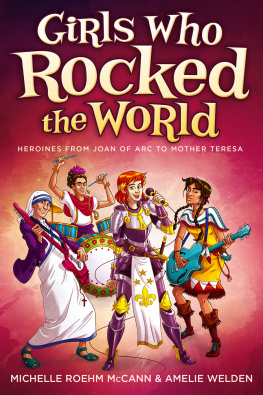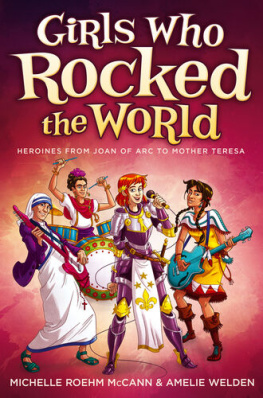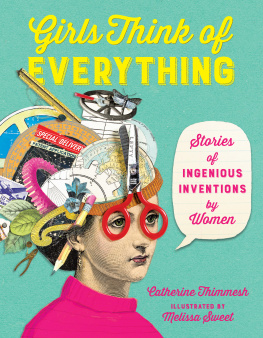CONTENTS

In the profiles in this book, passages of literary narrative based on factual events were imagined by the authors in an attempt to draw the reader into the life and perspective of the profiled girl.
For Fiona, my amazing girl.
I cant wait to see how you will rock the world.
Michelle
To all the many girls and women whove inspired me throughout my life.
Amelie
We stand at the beginning of a new epoch in the history of humankinds thought, as we recognize that... woman, like man, makes and defines history.
GERDA LERNER, PROFESSOR OF HISTORY, UNIVERSITY OF WISCONSIN

Note from the Authors
The future belongs to those who believe in the beauty of their dreams.
ELEANOR ROOSEVELT
W hat if we asked you to name some important people from historywho would you list? If youre like most of us, youd probably name more men than women. (If not, good for you!) But why do most people think of men when they consider influential people in history? Is it because women werent important? No way! Womens strength, ingenuity, and perseverance have always been vital in defining the worlds cultures and civilizations. Its just that many stories of women and girls have been left out of traditional history that gets recorded and taught.
Luckily, in recent years, progress has been made toward restoring womens roles in history. Most of you have read plenty of stories about amazing grown women and their achievementsAmelia Earhart, Susan B. Anthony, Rosa Parksand you probably thought to yourselves, Hey, when I grow up, maybe I can do something important like that! While our current history books are giving more credit to women from the past, it is equally important that you, todays girls, know that you can make your own impact on the history books of tomorrow.
With Girls Who Rocked the World , we want to show that you dont have to wait until you grow up. The girls in this book didnt wait until they were adults to start rocking the world.
And rocking the world doesnt necessarily mean you have to become famous and fabulously rich. It can mean you took a chance, made a change, inspired someone, stood up for yourself, ignored your critics, changed a persons mind, or comforted someone. It means you didnt just sit back and let the world rock you.
With these issues in mind, we set to work on Girls Who Rocked the World . We are proud to be a part of retelling the history of many amazing girls and hope that our work encourages you to believe in your dreams and in your power to make a difference.
With so many incredible girls out there, deciding who to include was pretty difficult. We chose girls who left their mark on historyor seriously began on their pathbefore the age of twenty and who reflect a diversity of countries, time periods, and achievements. Although the heroines in this book come from every corner of the globe and rocked the world in totally different ways, they do have a few important things in common. Each overcame obstaclespoverty, lack of education, family disapproval, sexist societies, oppressive governments, jealous husbands, and their own self-doubtsto realize their dreams. The road was not easy for any of them, but these girls didnt give up.
The age qualification made it impossible to include thousands of influential women whose achievements came later in lifeincredible women like Sojourner Truth, an African American slave who was a leader in the anti-slavery and womens rights movements; and Valentina Tereshkova, a Soviet astronaut who was the first woman in space. This was especially limiting in the sciences, since many women first had to complete years of study before making contributions to their fields.
As you read the following pages, remember that the girls in this book are just a few of the millions of girls who have done and will do amazing things. We hope their lives will inspire you as they have inspired us. They are definite proof that girls like you can achieve your goals, pursue your passions, and live your dreams. So now its your turn to go out there and rock the world! After all, in the words of famous girl speaker Anna Elizabeth Dickinson, The world belongs to those who take it.

Hatshepsut
APPROXIMATELY 15001460 BC

PHARAOH

EGYPT
[Hatshepsut] had no wish to be remembered merely for her sex, which she regarded as an irrelevance; she had demandedand for a brief time wonthe right to be ranked as an equal amongst the pharaohs.
JOYCE TYLDESLEY, HATCHEPSUT: THE FEMALE PHARAOH
T he Egyptians stood shoulder to shoulder, so crowded was the plaza. The sun beat down as they awaited the unveiling of the new royal monument. As the trumpets sounded and the slaves pulled the cloth away from the stone, people in the front rows strained their eyes to get a better look at the carving. What they saw shocked them, and they whispered to those farther back. Within minutes the scandal spread like a wave through the crowd, until everyone knew the surprising details.
In previous monuments, Hatshepsut was shown standing behind her husband, fulfilling her role as his queen consort; or standing beside her stepson, as his guardian and adviser. In this new carving, Hatshepsut stood completely alone. Even more shocking, Hatshepsut was boldly dressed as a man... in fact, she was dressed as the pharaoh! What could it mean? wondered the Egyptians. There had never been a woman pharaoh before. And what about her stepson, who was supposed to be pharaoh? The gods would not be pleased. The maat , the ideal state of the universe, would be disturbed.
Most Egyptians had six or seven children (but almost half died in childhood), and baby girls were just as welcome as baby boys. Popular names had meanings like Riches Come, Welcome to You, Ruler of Her Father, or even Hes a Big Fellow.

The girl who would one day become pharaoh was born the eldest daughter to the pharaoh King Tuthmosis I. When her infant sister died, she was raised as his only child. Before Hatshepsuts family came into power, Egypt had been fragmented and often ruled by foreigners. For generations, her royal family had struggled to unite a divided Egypt. Her father eventually achieved this feat, and his reign was a time of great prosperity. He was a beloved and powerful pharaoh to his people.
In order to keep the royal bloodline intact, most royal Egyptians married their siblings. Hatshepsut was no exception. When her father died, young Hatshepsut married her half-brother Tuthmosis II. She was most likely twelve at the time, as most Egyptian girls married around that age. Her brother became pharaoh, and Hatshepsut became his queen consort. She soon gave birth to a daughter, Princess Neferure. Carvings of Hatshepsut during this time show her wearing the clothes of a queen and standing behind her husband.
Many historians argue that Tuthmosis II was a weak and sickly king, and that it was Hatshepsut who secretly ruled. All we know for sure is that Tuthmosis II died when he was still a young man, and Hatshepsut wasted no time increasing her power. Tuthmosiss son from another woman became heir to the throne, as was Egyptian custom. When Hatshepsut was possibly as young as fifteen, she was named guardian to Tuthmosis III, who was about five years old, too young to be pharaoh. In carvings of this period, Hatshepsut is pictured standing next to her stepson, as she was expected to act as co-ruler until Tuthmosis III was old enough to rule alone. But Hatshepsut had plans of her own.













 PHARAOH
PHARAOH 